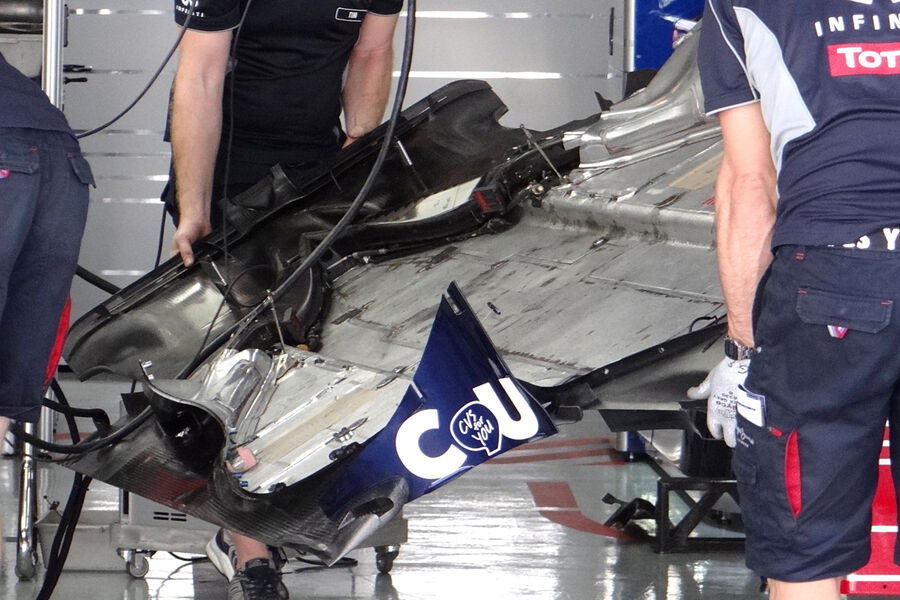

via AMuS














I would think it would act like Venturi and actually accelerate flow. Course I'm no F1 Aerodynamicist.e30ernest wrote:Interesting how the channels narrow down in the middle. I wonder, at certain speeds, would the narrow part block/slow airflow enough so it no longer enters the channels?















Why the T-tray of the car is hot?
The only answer that I can think of this, is that it often hits the ground, scraping it. That, or they are deliberately heating it.gary123 wrote:Why the T-tray of the car is hot?

It's very strange because other cars never heated up the T-tray(on the thermal camera videos )...Well lets just wait and see. And thanks for the article =D>turbof1 wrote:The only answer that I can think of this, is that it often hits the ground, scraping it. That, or they are deliberately heating it.gary123 wrote:Why the T-tray of the car is hot?
Oh, one more: doesn't red bull have it's capacitors installed in the floor?
http://scarbsf1.com/blog1/2012/04/17/re ... apacitors/
Not exactly the t-tray, but the article comes from last year, and the t-tray looks to be the lowest point of the car. Perhaps they moved it to there. Just a guess.
Yes, it is quite strange. It can't be regular airflow, and it even looks hotter then the sidepod-entrance. Certainly something mechanical/electronical running there. The way the heat pattern is shaped also doesn't look like that it comes from scraping the t-tray to the ground.gary123 wrote: It's very strange because other cars never heated up the T-tray(on the thermal camera videos )...Well lets just wait and see. And thanks for the article =D>
from scrabsturbof1 wrote: Oh, one more: doesn't red bull have it's capacitors installed in the floor?
Not exactly the t-tray, but the article comes from last year, and the t-tray looks to be the lowest point of the car. Perhaps they moved it to there. Just a guess.
The way the FIA F1 KERS rules are written there is a limit on the amount of energy that can be stored and reused. These limits are not in line with what is actually achievable with current technology. Teams are effectively capped on energy, as they could store and re-use far more. Part of the problems is that under braking, the energy harvesting is capable of producing more power than they are allowed to put into the battery. So the teams control the harvesting rate according the driver’s style and the circuits demands. Even then the harvesting potential is hard to predict. Rather than stopping the harvesting mid braking, which would unsettle the car. The teams keep the same harvesting rate, but dump the energy through a series of fixed rate resistors. Obviously these resistors quite large and create a huge amount of heat. This would explain their low position and cooling requirement.
These floor mounted devices might be the energy dumps, but they are particularly large and with increased experience of KERS teams are getting better at controlling the harvest rate, so shouldn’t need such a large dump. So it’s possible, but unlikely these are energy dumps.
Hm it would be interesting if this energy dumping could be used, for example heating the tires?.poz wrote:from scrabsturbof1 wrote: Oh, one more: doesn't red bull have it's capacitors installed in the floor?
Not exactly the t-tray, but the article comes from last year, and the t-tray looks to be the lowest point of the car. Perhaps they moved it to there. Just a guess.
The way the FIA F1 KERS rules are written there is a limit on the amount of energy that can be stored and reused. These limits are not in line with what is actually achievable with current technology. Teams are effectively capped on energy, as they could store and re-use far more. Part of the problems is that under braking, the energy harvesting is capable of producing more power than they are allowed to put into the battery. So the teams control the harvesting rate according the driver’s style and the circuits demands. Even then the harvesting potential is hard to predict. Rather than stopping the harvesting mid braking, which would unsettle the car. The teams keep the same harvesting rate, but dump the energy through a series of fixed rate resistors. Obviously these resistors quite large and create a huge amount of heat. This would explain their low position and cooling requirement.
These floor mounted devices might be the energy dumps, but they are particularly large and with increased experience of KERS teams are getting better at controlling the harvest rate, so shouldn’t need such a large dump. So it’s possible, but unlikely these are energy dumps.

Because it was scraping the ground. Webbers car was set up to low for first stint in FP1. They corrected this very quickly. Later on during sessions this area was only blue.gary123 wrote:Why the T-tray of the car is hot?
Yep , that the easy fix explanation.gandharva wrote:Because it was scraping the ground. Webbers car was set up to low for first stint in FP1. They corrected this very quickly. Later on during sessions this area was only blue.gary123 wrote:Why the T-tray of the car is hot?